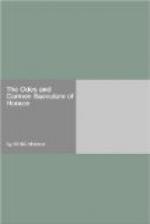“Eager for battle
here
Stood Vulcan, here matronal
Juno,
And with the bow to
his shoulder faithful
He who with pure dew
laveth of Castaly
His flowing locks, who
holdeth of Lycia
The oak forest and the
wood that bore him,
Delos’ and Patara’s
own Apollo,”—
admirably finished as it is, and highly pleasing as a fragment, scarcely persuades us that twenty stanzas of the same workmanship would be read with adequate pleasure, still less that the same satisfaction would be felt through six-and-thirty Odes. After all, however, a sober critic will be disposed rather to pass judgment on the past than to predict the future, knowing, as he must, how easily the “solvitur ambulando” of an artist like Mr. Tennyson may disturb a whole chain of ingenious reasoning on the possibilities of things.
The question of the language into which Horace should be translated is not less important than that of the metre; but it involves far less discussion of points of detail, and may, in fact, be very soon dismissed. I believe that the chief danger which a translator has to avoid is that of subjection to the influences of his own period. Whether or no Mr. Merivale is right in supposing that an analogy exists between the literature of the present day and that of post-Augustan Rome, it will not, I think, be disputed that between our period and the Augustan period the resemblances are very few, perhaps not more than must necessarily exist between two periods of high cultivation. It is the fashion to say that the characteristic of the literature of the last century was shallow clearness, the expression of obvious thoughts in obvious, though highly finished language; it is the fashion to retort upon our own generation that its tendency is to over-thinking and over-expression, a constant search for thoughts which shall not he obvious and words which shall be above the level of received conventionality. Accepting these as descriptions, however imperfect, of two different types of literature, we can have no doubt to which division to refer the literary remains of Augustan Rome. The Odes of Horace, in particular, will, I think, strike a reader who comes back to them after reading other books, as distinguished by a simplicity, monotony, and almost poverty of sentiment, and as depending for the charm of their external form not so much on novel and ingenious images as on musical words aptly chosen and aptly combined. We are always hearing




